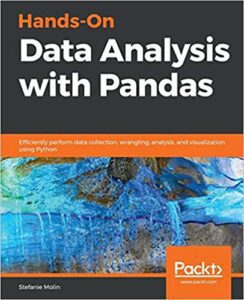Q: What is/are your specialist tech area(s)?
Stefanie: I’m a software engineer and data scientist, and a member of the Security Data Science team in Bloomberg’s CISO Office. We research and develop solutions using data and machine learning to help improve and automate Bloomberg’s information security processes. I focus on identifying and answering security-related questions using data and developing software to solve them.
Q: How did you become an author for Packt? Tell us about your journey. What was your motivation for writing this book?
Stefanie: From my previous experience creating a data analysis training course, I saw first-hand how rewarding it is to teach others, as well as how much you learn from being the teacher because it forces you to fill in gaps in your knowledge. In addition, having read several technical books, I wanted to eventually write one myself and contribute to the community, so when Packt approached me, I jumped on the opportunity.
Q: What kind of research did you do, and how long did you spend researching before beginning the book?
Stefanie: Since this is the Second Edition, I spent a few weeks going back through the First Edition, rerunning the code, and pouring over pandas’ documentation to identify new features, deprecations, and any areas for improvement. Once I had a detailed outline of the changes, I was able to quickly transition to writing.
Q: Did you face any challenges during the writing process? How did you overcome them?
Stefanie: Throughout the process of writing the Second Edition, I have been working full-time and pursuing a Master’s degree in Computer Science from Georgia Tech, so bandwidth was definitely an issue for me at times. What really helped was keeping all of my deadlines together and focusing on the most pressing ones.
Q: Why should readers choose this book over others already on the market? How would you differentiate your book from its competition?
Stefanie: The book covers statistics, working with APIs, data wrangling, data simulations, and visualization — along with machine learning using scikit-learn built on top of these. The goal is for readers to apply the skills they’ve learned to conduct an analysis entirely in Python, meaning they can find, manipulate, and visualize their data; build a machine learning model; and analyze the results. I want readers to be able to connect what’s in the book to their work, so I used some realistic examples. Readers will also pick up valuable software engineering skills along the way, vastly expanding their data science toolbox.
Q: What are the key takeaways you want readers to come away from the book with?
Stefanie: I want readers to come away with the confidence that they can conduct their own analyses using pandas and feel comfortable searching for answers if they get stuck. A big part of coding is looking things up, whether it be in the documentation or on Stack Overflow. So, having background knowledge on the tools you are using and knowing what you want to do often makes the difference between finding the solution quickly and struggling.
Q: What advice would you give to readers learning tech? Do you have any top tips?
Stefanie: There’s a lot of information out there, and it’s easy to get overwhelmed. Get a handle on the basics first, and then let your curiosity guide you.
Q. What is that one writing tip that you found most crucial and would like to share with aspiring authors?
Stefanie: If you fail to plan, you plan to fail. I work best when I can prioritize everything by setting deadlines. By creating a detailed outline and keeping all my due dates in one place, I can make sure that things get done on time.
You can find Stefanie’s books on Amazon by clicking on the cover image:










